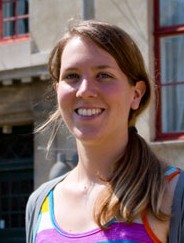Maria Guidi
I got my Bachelor's degree in Physics at the University of Bologna (Italy) with a thesis entitled "Imaging Techniques in 3D Echocardiography" and my Master's degree in Physics at the University of Copenhagen (Denmark), where I graduated in September 2013 with the thesis "Scale Selection in Fracture Patterns: A Case Study in Columnar Joints".
My educational experiences abroad comprised: one year at the University of Iceland (Reykjavík, Iceland, 2008-2009), one year at the University of Chile (Santiago, Chile, 2011-2012) and one year at the Niels Bohr Institute (Copenhagen, Denmark, 2012-2013).
I started my PhD programme within the initial training network "HiMR" in October 2013 at the Nuclear Magnetic Resonance Unit, part of the Max Planck Institute for Human Cognitive and Brain Sciences in Leipzig, Germany.
My supervisor is Prof. Dr. Harald Möller and my research interests span from high resolution functional Magnetic Resonance Imaging (fMRI) based on Blood-Oxygenation Level Dependent (BOLD) and non-BOLD contrasts, to high parallel imaging acceleration factors and 3D Echo-Planar Imaging (EPI) schemes
Project Title: Ultra-high resolution fMRI acquisition and data analysis
Supervisor: Prof. Harald Möller
Centre: Max Planck Institute, Leipzig
Secondment: Radboud
Project Description
The increased CNR and spatial localisation provided by UHF fMRI will allow cortical information processing to be characterised with high spatial specificity, including distribution of neural activity across cortical layers fMRI. Improved sequences are required to achieve high spatial resolution, whilst overcoming problems of limited volume coverage, high sensitivity to distortion, long repetition times (low temporal resolution) and high power deposition. The ESRs will explore high parallel imaging acceleration factors in 2D and 3D sequences and the use of multi-band excitation. This WP will benefit from optimized RF coil and pulse design developed using information from WP 10 by ESR D on secondment and RAPID, and links with WP 12 on motion amelioration. For ultra-high resolution, spin echo (SE) BOLD is thought to be more spatially specific than GRE, but at a cost of reduced CNR and increased power deposition. The ESRs will determine optimal sequence parameters for ultra-high resolution fMRI for GRE BOLD, using 2D/3D EPI schemes, SE BOLD, and non-EPI schemes. ESR D will explore the exploitation of the phase data from BOLD images at UHF for improved functional localisation and distortion correction. Image analysis methods must be improved for fusing high-resolution functional and anatomical MRI data. The ESRs will assess software for image registration and cortical segmentation, inflation and flattening, and explore optimal statistical analysis methods, including machine learning algorithms for multivariate classification.
Outreach:
Meetings Attended: Joint Annual Meeting ISMRM/ESMRMB 2014 (Milan)
Publications:Should beginners revisit the “Ancient and Honourable Art of Shimming” at high fields?
M. Martínez-Maestro, M. Guidi, C. Labadie, H. E. Möller (2014). ISMRM poster
Adaptive motion correction of single-voxel spectroscopy with real-time frequency correction at 3 T and 7 T C
Labadie, T. Siegert, E. Reimer, M. Guidi, M. Martínez-Maestro, H. E. Möller, R. Turner, J. Schulz (2014). ISMRM poster
Layer-dependent CBV and BOLD responses in humans, monkeys, and rats at 7T
L. Huber, J. Goense, A. Kennerley, R. Trampel, M. Guidi, C. Gauthier, R. Turner, H. E. Moller.
ISMRM Workshop ("Functional MRI: Emerging Techniques & New Interpretations")
Contact: guidi@cbs.mpg.de
CV: